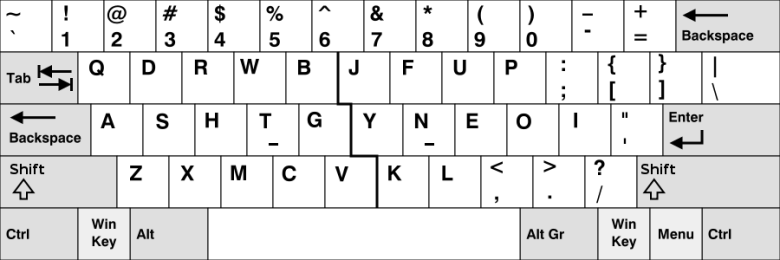pages/blog/workman.md (view raw)
1 2 3 4 5 6 7 8 9 10 11 12 13 14 15 16 17 18 19 20 21 22 23 24 25 26 27 28 29 30 31 32 33 34 35 36 37 38 39 40 41 42 43 44 45 46 47 48 49 50 51 52 53 54 55 56 57 58 59 60 61 62 63 64 65 66 67 68 69 70 71 72 73 74 75 76 77 78 79 80 81 82 83 84 85 86 87 88 89 90 91 92 93 94 95 96 |
--- template: slug: workman title: The Workman keyboard layout subtitle: I have a lot of free time on my hands (heh) date: 2020-10-24 --- I've been at my computer everyday, for at least 10 hours at minimum. These past ~6 - 7 months have been the most I've ever used my computer. Eventually, I started experiencing discomfort and pain -- especially in my pinkie finger. Typing became a chore, and I found myself using my shell's command history more just to avoid typing commands. I tried using a wrist rest, different keyboard heights, but nothing helped. Thus began my search for a new keyboard layout, and it swiftly concluded once I chanced upon the [Workman layout](https://workmanlayout.org). According to the website, it is supposedly an improvement over Colemak and Dvorak. I skimmed through the numbers and other stats, but I honestly didn't care. "Oh it's better than the popular alternative layouts? Okay that's enough for me."  I downloaded the tarball containing the different config files for different platforms etc. I just needed the `xmodmap` -- that's the easiest way to apply a keyboard layout. ```console $ xmodmap xmodmap.workman ``` To practice the layout, I used [keybr.com](https://keybr.com). You can configure the keyboard layout via the settings. Naturally, the first few days were incredibly painful. I was only able to type short sentences with very small words. I tried to not engage in heated discussions on IRC, for I could not type up a response in time. However, if I did stumble into one, I would switch back to QWERTY just for those couple of messages. I found myself making the switch less and less, over the next few days. Chatting on IRC is a _great_ way to learn a layout. Or chatting anywhere, really. It forces you to get accustomed to the layout by typing the common words used in conversation. I also made a tiny change to the layout -- swapping the <kbd>F</kbd> and <kbd>B</kbd> keys, since typing the "fo" / "of" digram in the same hand felt really weird. Soon enough, I was averaging about 30 - 40 WPM within the first week of having switched to Workman. And then things at work started to pick up, and I had to do what I had been dreading the most: edit code -- in Vim. It's fairly common knowledge that Vim, by default, extensively uses the <kbd>H</kbd>, <kbd>J</kbd>, <kbd>K</kbd> and <kbd>L</kbd> keys for navigation. Sure, there are better ways to move around and only using those keys is frowned upon -- but it's a habit built over years, and hard to shake off. After poking around for a bit, I found the [vim-workman](https://github.com/nicwest/vim-workman) plugin. Forked it to apply the <kbd>F</kbd>/<kbd>B</kbd> change, and I began using it. It was great at first. My Vim muscle memory was not hampered, as I was able to use QWERTY in normal mode, and Workman in insert. But as I got better at Workman, I found myself instinctively reaching for the Workman keys in normal mode. Well, everything except for the <kbd>H</kbd>, <kbd>J</kbd>, <kbd>K</kbd> and <kbd>L</kbd> keys. This quickly became bothersome and I uninstalled the plugin to search for a better solution. Wait, don't I have a sick new [programmable mechanical keyboard](/blog/ducky-one-2)? What if I configure a layer on it just for the <kbd>H</kbd>, <kbd>J</kbd>, <kbd>K</kbd>, <kbd>L</kbd> keys? After pouring through the manual for a bit, I eventually got it set up. I even remapped the <kbd>Caps Lock</kbd> key to <kbd>Fn</kbd> so it's easier to access the layer. So now, hitting <kbd>Caps Lock</kbd>+<kbd>Y</kbd>/<kbd>N</kbd>/<kbd>E</kbd>/<kbd>O</kbd> results in <kbd>HJKL</kbd> being pressed. This took a little bit of getting used to, but it got easier with a bit of practice. Since I don't rely on any plugin/remappings, I can use Vim as is on remote machines too. Another bonus from this adventure was I actually spent time learning better ways to navigate, and reduce my reliance on <kbd>HJKL</kbd>. Overall, a big win. It's been over 4 weeks since my switch, I think, and I'm comfortably averaging around 80 WPM. Still a good 20 WPM slower than QWERTY, but I think it'll get better with time. And am I still able to use QWERTY? Well, kinda. I still use QWERTY on my phone keyboard, since Workman isn't an option on it and it's actually alright. However, when I use my desktop to play Dota, I prefer using voice chat to communicate since typing on QWERTY takes too long -- I am forced to hunt and peck. Interestingly, after about 15 - 20 minutes on QWERTY, my brain kinda just clicks back and I can type on it with relative ease. Not as fast as I used to be, but it's manageable. All things considered, switching to Workman was one of the better decisions I have made in life. It feels so nice to be able to type out whole words in just the home row. It just _flows_ so nicely, and it has made typing so much more enjoyable again. |